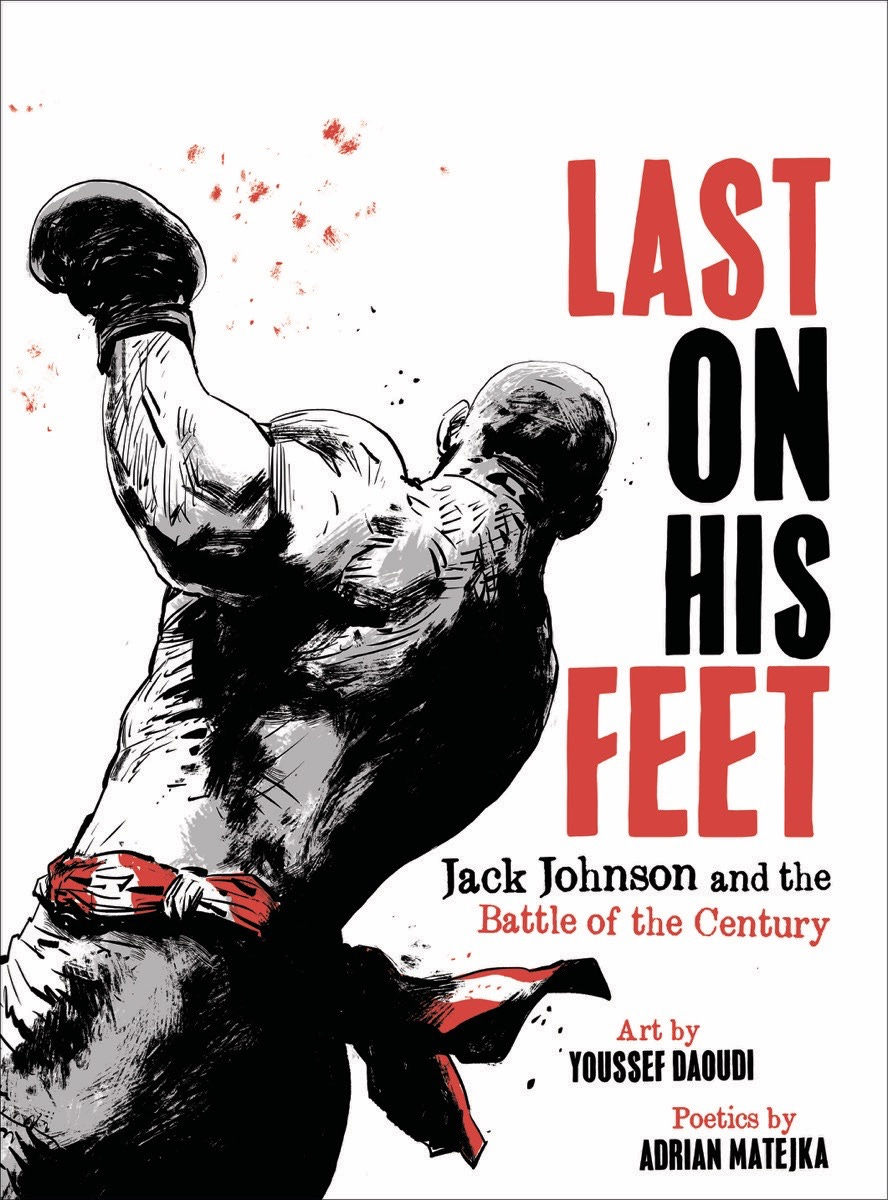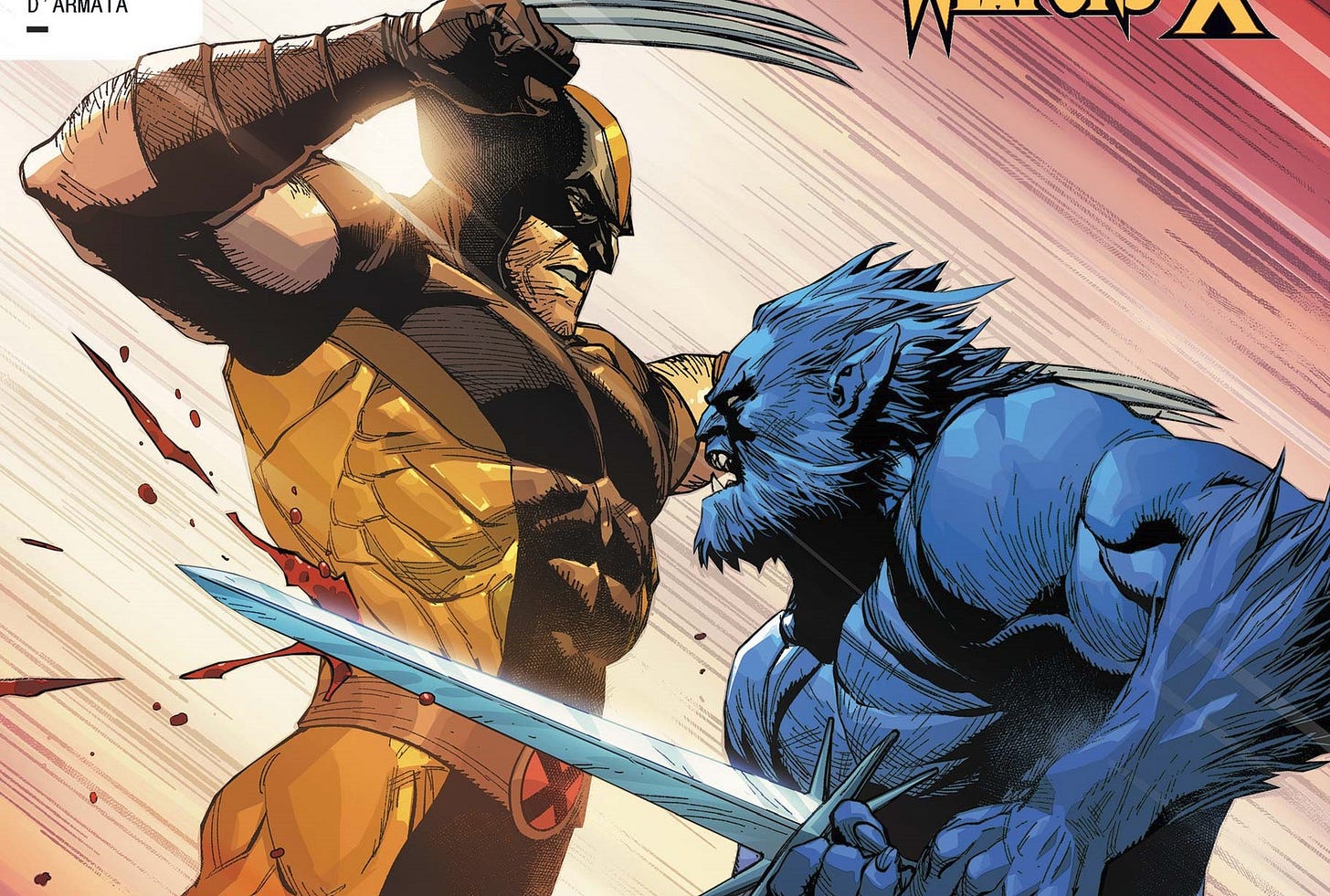The Wolverine and the Beast
and thoughts on Last on His Feet
Over the Thanksgiving holiday I took it easy. I decided not to write and just spend the extended weekend catching up on a whole lot of reading. Do you know how many comic books come out in a year?! I also got double-vaxed on Saturday and I have some incredible brain-fog. So you’ll forgive me if this edition is not fully coherent.
Last time I shared a couple books from 2023 that I had read and I thought were quite good. This week, I have another to share. I also read some forgettable books but we shall not speak of those. People worked hard on them.
This is the story of the world’s first black heavyweight champion and the lifetime of controversy and hate that trailed him—and all of the people in his life—until the day he died. The book is structured primarily around Johnson’s climactic showdown with the former champ, who white America viewed as the last hope to take their country back from what Johnson signified. The book flashes back and forth to different chapters in Johnson’s tragic and complicated life. The way the narrative returns to that fight, how every blow in the ring echoes across time, gives the book a timeless, epic feel. It is as poetic and epic and quintessentially American a tale of sports, culture, and despair, as Casey at the Bat or John Henry. It feels like it always existed.
But a big part of my week has been catching up on almost 2 years of Ben Percy’s X-Men books.
Random Comic Panel of the Week
The Beast and The Wolverine
I’ve been collecting and piling up issues of Wolverine every month and never reading it since X Lives and Deaths of Wolverine. It’s not because I didn’t want to read it. I love what Ben Percy was doing with the character in that first year and change on the title. I wrote about it on the site. But I also knew that Percy’s storytelling worked better in chunks when you can appreciate his lyrical approach to the story beats and dialogue and, more importantly, track the slowly simmering and intricate threads. This week, with a few days of from work, I finally climbed Mount Logan, supplementing it with X-Force because I knew Beast would play a role in the Wolverine solo. I wanted to understand Beast’s trajectory to appreciate the big climactic story with ol’ Hank McCoy.
Somewhere in the last few years, someone at Marvel decided that the Hank McCoy character had crossed the line from a character who was compelling in his morally dubious but ultimately well-meaning and heroic actions, to irredeemable villain. A decision was made to find a way to reboot the character to his more happy-go-lucky, Avengers-era, X-Men Animated series persona, where he was erudite and a bit arrogant and self-loathing but also quippy and lovable. But Ben Percy said WAIT! Let me take this version of Beast to his ultimate extreme. With a throwaway line about how the X-Men’s resurrection protocols have that classic Beast saved away as the only remaining back-up of his personality, Percy throttled Beast’s utilitarian worldview into overdrive until he was a full-on terrorist war-criminal, who doesn’t so much as hesitate to brainwash and torture his allies and old friends.
I am less into Percy’s X-Force than I am his Wolverine as a book, but having it as a companion piece on Beast’s descent is illuminating and adds to my appreciation for the way he has positioned Beast as a climactic endgame for his run on Wolverine (at least in the Krakoa era, for all I know Ben Percy will write Wolverine forever.)
As a character, this troubled and detached Beast of the aughts through now is a perfect counterpoint to Wolverine. Hank McCoy is a man who has slowly come to view himself as a tool and weapon more than a human being. Over the years he has become less human, physically and emotionally. As his form becomes more animalistic, his view of the world has become stripped of human ideas of ethics and morals, viewing the relatonship between human and mutants from a purely evolutionary standpoint. Decades of hatred—external and internal— and traumatic genocides against his people has metasticized within Beast’s soul until he no longer even recognizes the name of Henry McCoy. All of the decisions he has made have slowly chipped away at his humanity. It’s a stirring counterpoint to Wolverine, a man who was rapidly turned into an inhuman weapon and stripped of agency and emotion, who has spent most of his life trying to regain a sense of that lost humanity.
Beast’s journey has been a steady but consistent one, but every compounding moral compromise built and twisted him until the last few years when those failures stopped being something he wrestled with and a part of himself he accepted. As he became more animalistic his moral code became more utilitarian and self serving—under the guise of mutant safety.
But Wolverine has spent decades trying to tear away the chains and mental scars that told him he was a mere animal. Wolverine defines himself by his constant battle to fight against his base urges and the twisted ways humanity has tried to tell him he is less. Wolverine fights as a member of the X-Men less because he cares deeply about Xavier’s dream of human/mutant peace but because it gives him a way to channel his violence for the sake of building a better future. He is unable to fully embrace Krakoa both because he sees no place for an unforgivable man like him in it but also because his dream is not about mutant kind. It is about a world free of men like him and those who would create more. But Beast sees an individual, a cold, calculating, dispassionate killer, as not just necessary but important. It is his mind, his ability to make morally questionable choices for the greatest good for the greatest number of mutants. Might makes right, and right is defined by what Beast’s calculations say will benefit mutant kind. But what is good for mutant kind must also mean what brings him comfort and power and respect.
Wolverine knows that violence can bring easy solutions to many problems. But he fights for a world where his kind of problem solving will be irrelevant. He is weary of a hundred lifetimes of war. Beast revels in global conflict that makes him feel powerful.
Having these two twisted reflections of one another, who early on seemed to view the harsh reality of X-Force as a regrettable common good, come to irreconcilable differences is a brilliant stroke from Ben Percy, and it only has the gravitas it does becasue he was given the uninterrupted runway to tell this story with these characters for four years. Beast and Wolverine as opposing forces would not have been logical or inevitable before now. But as a conclusion to an ongoing and intentionally, slowly plotted serializd story, it is more satisfying, more tragic, and more compelling than it would be if it was just plucked out of disparate parts of different writers’ stories. Percy saw the history of both of these characters and set them up on parallel journeys that could only end with them in deadly opposition.
Of course, Percy’s not alone. He’s been aided by a murderer’s row of talented artists including Joshua Cassara and Andy Kubert. But in this kind of longform storytelling where artists come and go, it is the writer’s voice that ultimately stands out. But the visuals of the bloated Beast and the barely sheathed savagery of Wolverine has brought that voice to life. Beast stuffing his face with lobster as he monologues to a disgusted Wolverine is unforgettable. It is the height of the conflict between the two. Beast is awash in extravagance and savagery, despite his erudite pretensions. It is Wolverine, whom Beast views as a lout and base creature that is recognizably human. Juan Jose Ryp’s artwork sells the contrast in stunning fashion.
It’s astonishing to look at Percy’s time at Marvel—in the period he has worked there—and see him given so much time to play without being forced to acommodate larger initiatives or relaunch his book. In an era when Marvel cancels and relaunches a book at arbitrary moments, that he has been given the freedom to lay so many plot threads and pay them off is remarkable. Not since Brian Bendis has a writer had the opportunity to weave so intricate a story for any set of characters in any mainstream superhero title. But the potential for these kind of longform stories is one of the biggest assets superhero comics have that no other genre in no other medium have. We should all be grateful that we’ve had the chance to read these books. Not every part of these individual issues has worked (I always felt like there were pieces missing from certain stories that just kind of disappeared) but the macro story is an all-timer. Percy does not reinvent either Beast or Wolverine but he synthesizes decades of history into something singularly compelling and focused.
That’s all now, Turtle Club Faithful. Catch you later.
Tim






